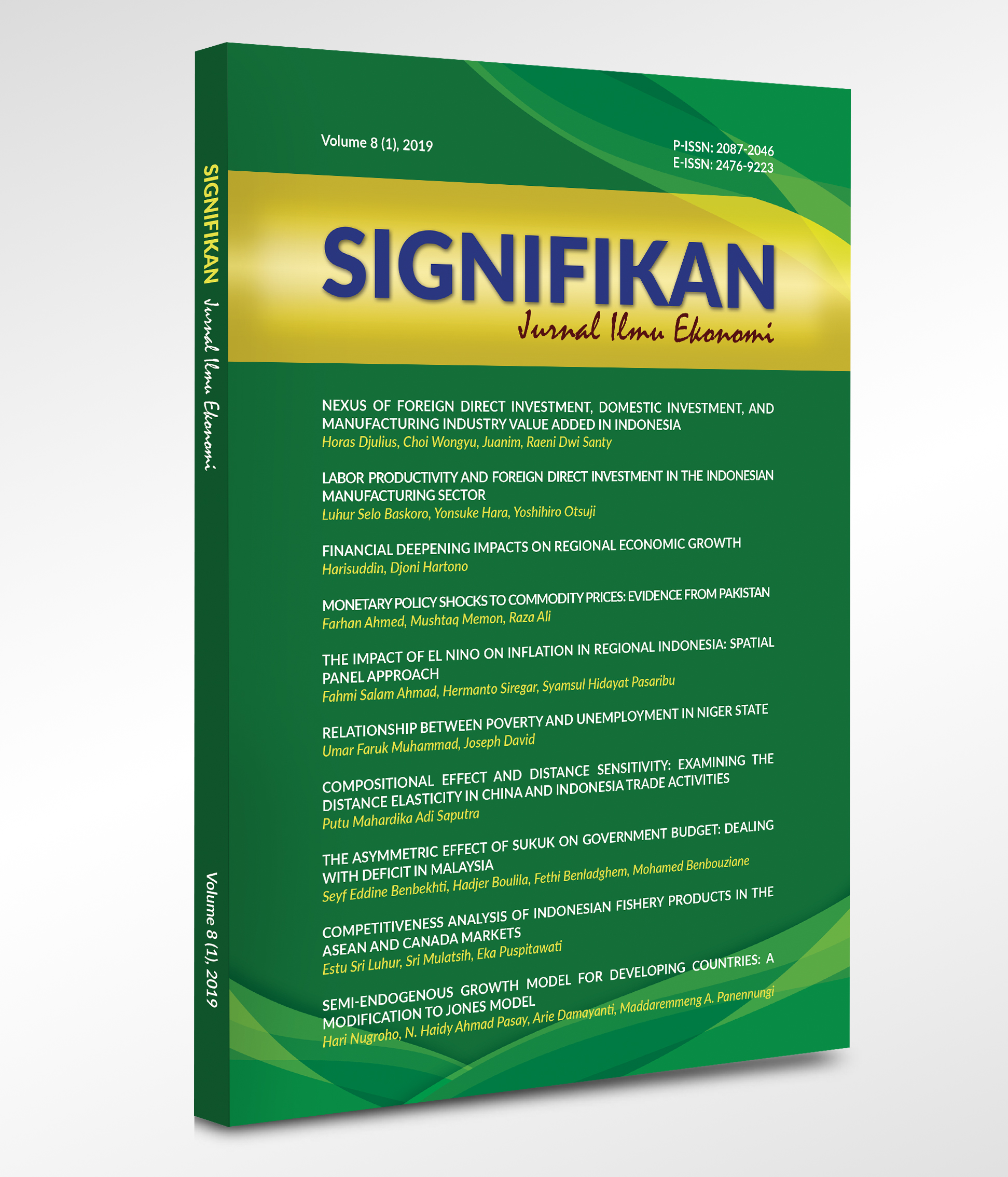The Asymmetric Effect of Sukuk on Government Budget: Dealing with Deficit in Malaysia
DOI:
https://doi.org/10.15408/sjie.v8i1.8068Keywords:
Islamic sukuk, government budget, deficit, non-linear ARDLAbstract
Islamic economists sought to find transactions that fit and conform to the principles of Islamic religion, where Islamic bonds were one of the most critical products compatible with Islam. This study aims to shed light on the impact of Sukuk as one of the alternatives available for funding expenditures and deficit in Malaysia. This research using a non-linear autoregressive distributed lag model (NARDL) during the period 1990-2016. After identifying the asymmetric effect and the dynamic multiplier of Sukuk on government budget balance during the fluctuations of the exchange rate of the Ringgit, we have found that Islamic bonds are a very useful tool in financing deficit making Malaysia a pioneering experience in the field of Islamic engineering
References
Abduh, M., & Omar, M. A. (2012). Islamic Banking and Economic Growth: The Indonesian Experience. International Journal of Islamic and Middle Eastern Finance and Management, 5(1), 35–47. https://doi.org/10.1108/17538391211216811
Ahmad, N., & Muda, M. (2013). Exchange Rate Pass-through Estimates for Sukuk Issuing Countries. Procedia Economics and Finance, 7, 134–139. https://doi.org/10.1016/S2212-5671(13)00227-X
Akhtar, S., & Jahromi, M. (2015). Impact of The Global Financial Crisis on Islamic and Conventional Stocks and Bonds. Accounting and Finance, 57(3), 623–655. https://doi.org/10.1111/acfi.12136
Al-Mukit, D. M., Shafiullah, A. Z. M., & Ahmed, M. R. (2013). Inflation Led Import or Import Led Inflation: Evidence from Bangladesh. Asian Business Review, 2(4), 7–11.
Al-Raeai, A. M., Zainol, Z., & Rahim, A. K. A. (2018). The Role of Macroeconomic Factors on Sukuk Market Development of Gulf Cooperation Council (GCC) Countries. International Journal of Economics and Financial Issues, 8(3), 333–339.
Al Parisi, S., & Rusydiana, A. S. (2017). The Comparison of Sukuk and Bond Absorption: Deficit Budget Financing in Indonesia. Tazkia Islamic Finance and Business Review, 10(2), 107–121.
Amaliah, I., & Aspiranti, T. (2017). State Sukuk Potential in Reducing Indonesia Budget Deficit, 2009-2015. Ventura, 20(1), 21–30. https://doi.org/10.14414/jebav.v20i1.781
Devadason, E. S. (2015). Malaysia’s 2016 Budget: Pursuing Fiscal Consolidation While Skirting Critical Growth Concerns. Singapore: Institute of Southeast Asian Studies.
Dissanayake, D. M. S. B. (2016). Identifying the Relationships between Budget Deficit and Selected Macroeconomic Variables: A Study of Sri Lanka During the Postliberalization Era. In Proceeding 13th International Conference on Business and Management.
Hamilton, J. D. (2012). Import Prices and Inflation. International Journal of Central Banking, 8(1), 271–279.
Hassan, M. K., Paltrinieri, A., Dreassi, A., Miani, S., & Sclip, A. (2018). The Determinants of Co-movement Dynamics Between Sukuk and Conventional Bonds. The Quarterly Review of Economics and Finance, 68, 73–84. https://doi.org/10.1016/j.qref.2017.09.003
Islam, M. A. (2013). Impact of Inflation on Import: An Empirical Study. International Journal of Economics, Finance and Management Sciences, 1(6), 299–309. https://doi.org/10.11648/j.ijefm.20130106.16
Manzoor, D., Karimirizi, M., & Mostafavisani, A. (2017). Financing Infrastructure Projects Based on Risk Sharing Model: Istisna Sukuk. Journal of Emerging Economies and Islamic Research, 5(3), 72–84.
Mitsaliyandito, R. Q., & Arundina, T. (2018). Dynamic Relationship Between Sovereign Bond and Sukuk Market Developments in Indonesia. Pertanika: Social Sciences and Humanities, 26(S), 27–38.
Naifar, N., Mroua, M., & Bahloul, S. (2017). Do Regional and Global Uncertainty Factors Affect Differently the Conventional Bonds and Sukuk? New Evidence. Pacific-Basin Finance Journal, 41, 65–74. https://doi.org/10.1016/j.pacfin.2016.12.004
Rahman, N. H. A. (2012). The Relationship Between Budget Deficit and Economic Growth from Malaysia’s Perspective: An ARDL Approach. In International Conference on Economics, Business Innovation (pp. 54–58).
Saiti, B., Dewandaru, G., & Masih, M. (2013). A Wavelet-based Approach to Testing Shari’ah-compliant Stock Market Contagion: Evidence from The ASEAN Countries. Australian Journal of Basic and Applied Sciences, 7, 268–280.
Shin, Y., Yu, B., & Greenwood-Nimmo, M. (2014). Modelling Asymmetric Cointegration and Dynamic Multipliers in a Nonlinear ARDL Framework. In R. Sickles & W. Horrace (Eds.), Festschrift in Honor of Peter Schmidt. New York: Springer.
Smaoui, H., & Nechi, S. (2017). Does Sukuk Market Development Spur Economic Growth? Research in International Business and Finance, 41, 136–147. https://doi.org/10.1016/j.ribaf.2017.04.018
Zin, M. Z. M., Sakat, A. A., Ahmad, N. A., Nor, M. R. M., Bhari, A., Ishak, S., & Jamain, M. S. (2011). The Effectiveness of Sukuk in Islamic Finance Market. Australian Journal of Basic and Applied Sciences, 5(12), 472–478.
Zulkhibri, M. (2015). A Synthesis of Theoretical and Empirical Research on Sukuk. Review, Borsa Istanbul, 15(4), 237–248. https://doi.org/10.1016/j.bir.2015.10.001

